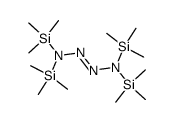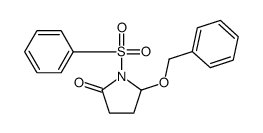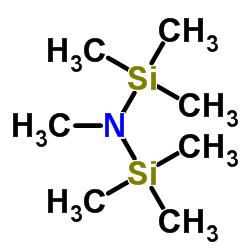Sodium bis(trimethylsilyl)amide

Sodium bis(trimethylsilyl)amide structure
|
Common Name | Sodium bis(trimethylsilyl)amide | ||
|---|---|---|---|---|
| CAS Number | 1070-89-9 | Molecular Weight | 183.375 | |
| Density | 0.904 g/mL at 25 °C | Boiling Point | 67°C | |
| Molecular Formula | C6H18NNaSi2 | Melting Point | 171-175 °C(lit.) | |
| MSDS | Chinese | Flash Point | 43 °F | |
| Symbol |


GHS02, GHS05 |
Signal Word | Danger | |
| Name | Sodium bis(trimethylsilyl)amide |
|---|---|
| Synonym | More Synonyms |
| Density | 0.904 g/mL at 25 °C |
|---|---|
| Boiling Point | 67°C |
| Melting Point | 171-175 °C(lit.) |
| Molecular Formula | C6H18NNaSi2 |
| Molecular Weight | 183.375 |
| Flash Point | 43 °F |
| Exact Mass | 183.087540 |
| PSA | 3.24000 |
| LogP | 2.42250 |
| Storage condition | 2-8°C |
| Symbol |


GHS02, GHS05 |
|---|---|
| Signal Word | Danger |
| Hazard Statements | H225-H314 |
| Supplemental HS | May form explosive peroxides., Reacts violently with water. |
| Precautionary Statements | P210-P280-P305 + P351 + P338-P310 |
| Hazard Codes | F:Flammable;C:Corrosive; |
| Risk Phrases | R14/15;R34 |
| Safety Phrases | S26-S45-S62-S36/37/39-S33-S16-S43-S8 |
| RIDADR | UN 3263 8/PG 2 |
| WGK Germany | 3 |
| Packaging Group | III |
| Hazard Class | 4.3 |
| HS Code | 2931900090 |
|
~85% 
Sodium bis(trim... CAS#:1070-89-9 |
| Literature: Mansell, Stephen M.; Perandones, Bernabe Fernandez; Arnold, Polly L. Journal of Organometallic Chemistry, 2010 , vol. 695, # 25-26 p. 2814 - 2821 |
|
~99% 
Sodium bis(trim... CAS#:1070-89-9 |
| Literature: Wiberg, Nils; Bayer, Heiner; Vasisht, Sham Kumar; Meyers, Rene Chemische Berichte, 1980 , vol. 113, # 9 p. 2916 - 2927 |
| Precursor 2 | |
|---|---|
| DownStream 9 | |
| HS Code | 2931900090 |
|---|---|
| Summary | 2931900090. other organo-inorganic compounds. VAT:17.0%. Tax rebate rate:13.0%. Supervision conditions:AB(certificate of inspection for goods inward,certificate of inspection for goods outward). MFN tariff:6.5%. General tariff:30.0% |
|
Effect of concentration of trimethylchlorosilane (TMCS) and hexamethyldisilazane (HMDZ) silylating agents on surface free energy of silica aerogels.
J. Colloid. Interface Sci. 356(1) , 298-302, (2011) The surface free energy of a solid determines its surface and interfacial behavior in processes like wetting and adhesion which is crucial for silica aerogels in case of organic liquid absorption and ... |
|
|
Regulation of mitochondrial ceramide distribution by members of the BCL-2 family.
J. Lipid Res. 56 , 1501-10, (2015) Apoptosis is an intricately regulated cellular process that proceeds through different cell type- and signal-dependent pathways. In the mitochondrial apoptotic program, mitochondrial outer membrane pe... |
|
|
A facile two-step dipping process based on two silica systems for a superhydrophobic surface.
Chem. Commun. (Camb.) 47(38) , 10761-3, (2011) A silica microsphere suspension and a silica sol are employed in a two-step dipping process for the preparation of a superhydrophobic surface. It's not only a facile way to achieve the lotus effect, b... |
| Sodium 1,1,1,3,3,3-hexamethyldisilazan-2-ide |
| MFCD00009835 |
| NaHMDS (contains 2-Methyl-2-butene) |
| EINECS 213-983-8 |
| NaHMDS |
| sodium,bis(trimethylsilyl)azanide |
| Sodium Bis(trimethylsilyl)amide (contains 2-Methyl-2-butene) |
| Silanamine, 1,1,1-trimethyl-N-(trimethylsilyl)-, sodium salt (1:1) |
| Sodium Hexamethyldisilazide (contains 2-Methyl-2-butene) |
| Sodium Bis(Trimethylsilyl)Amide |
| Hexamethyldisilazane Sodium Salt (contains 2-Methyl-2-butene) |
| Sodium bis(trimethyls |
| Hexamethyldisilazane Sodium |


 CAS#:111711-95-6
CAS#:111711-95-6 CAS#:920-68-3
CAS#:920-68-3 CAS#:41836-21-9
CAS#:41836-21-9 CAS#:22749-09-3
CAS#:22749-09-3 CAS#:180253-66-1
CAS#:180253-66-1 CAS#:18054-46-1
CAS#:18054-46-1![[Bis(trimethylsilyl)amino][dichlormethylen]phosphan structure](https://image.chemsrc.com/caspic/043/80920-95-2.png) CAS#:80920-95-2
CAS#:80920-95-2 CAS#:112438-24-1
CAS#:112438-24-1
